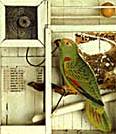Strange 'twin' new worlds found
Thursday, 3 August 2006, 20:50 GMT 21:50 UK
news.bbc.co.uk/2/hi/5241774.stm?ls
A pair of strange new worlds that blur the boundaries between planets and stars have been discovered beyond our Solar System ...
The pair belongs to what some astronomers believe is a new class of planet-like objects floating through space; so-called planetary mass objects, or "planemos" (an unofficial term), which are not bound to stars ... they circle each other rather than orbiting a star.
"This is a truly remarkable pair of twins - each having only about 1% the mass of our Sun," said Ray Jayawardhana of the University of Toronto, co-author of the Science paper ... "We are resisting the temptation to call it a 'double planet' because this pair probably didn't form the way that planets in our Solar System did," said co-researcher Valentin Ivanov of the European Southern Observatory (ESO) in Santiago, Chile ...
They ... can be found in the Ophiuchus star-forming region some 400 light years away. They go under the official name Oph 162225-240515, or Oph 1622 for short.
Mini-planet system seen in growth
Tuesday, 8 February, 2005, 11:07 GMT
news.bbc.co.uk/2/hi/science/nature/4246023.stm
Mini-planet systems get stranger
Tuesday, 6 June 2006, 13:34 GMT 14:34 UK
news.bbc.co.uk/2/hi/science/nature/5051706.stm
Professor Jayawardhana, who also worked on the study, added: "The diversity of worlds out there is truly remarkable. Nature often seems more prolific than our imagination."
Planet hunters target nearby star
news.bbc.co.uk/2/hi/science/nature/3237575.stm
By Helen Briggs
Friday, 7 November, 2003, 14:48 GMT
Telescope pierces space dust: Photo Gallery (7 Images)
Thursday, 18 December, 2003, 22:04 GMT
news.bbc.co.uk/2/hi/in_depth/photo_gallery/3332537.stm
Nasa's new infra-red telescope — now named the Spitzer Telescope — can see through clouds of dust that visible light can't penetrate






No comments:
Post a Comment